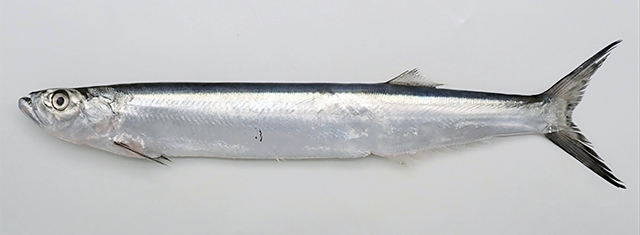| Chirocentridae (Wolf herring) |
| 100 cm SL (male/unsexed); 36.6 cm SL (female) |
|
reef-associated; brackish; marine; depth range 0 - 120 m, amphidromous |
| Indo-Pacific: probably throughout the warmer coastal waters, from the Red Sea and East Africa to the Solomon Islands, north to southern Japan, south to northern Australia. Recently reported from Tonga (Ref. 53797). |
|
Dorsal spines (total): 0-0; Dorsal soft rays (total): 16-19; Anal spines: 0-0; Anal soft rays: 29-36. Diagnosis: The slightly shorter pectoral fin, 11-13% of standard length, and the black marking of the upper part of the dorsal fin are the only satisfactory characters separating this species from Chirocentrus nudus; there is also some black on the anterior part of the anal fin (Ref. 188).
Description: With numerous dagger-like teeth (Ref. 37816). Lower gillrakers 12-16 (Ref. 6595). Pectoral fin shorter than distance between eye centre and hind border of gill cover, 11-13% of standard length; dorsal fin with 4-5 unbranched and 12-14 branched rays; anal fin with 3-4 unbranched and 26-32 branched rays; pectoral fin with 1 unbranched and 13-15 branched rays; pelvic fin with 1 unbranched and 6-7 branched rays (Ref. 2871, 6595, 30573). Scales numerous, small, usually lost (Ref. 6595, 37816). Belly without scutes (Ref. 6595).
Colouration: Silvery; back bright blue, fading to grey; flanks bright silver (Ref. 37816). |
| Occurs inshore, including brackish waters (Ref. 12743), from the shore to a depth of about 120 m (Ref. 30573). In Australia, it was reported in water temperatures of 26.0-29.0 °C (Ref. 4959). It feeds mainly on small fish and crustaceans (Ref. 188, 30573). Voracious predators of small schooling fishes, e.g. herrings and anchovies (Ref. 37816). Marketed fresh, frozen or dried and salted. |
|
Least Concern (LC); Date assessed: 02 March 2017 Ref. (130435)
|
| harmless |
Source and more info: www.fishbase.org. For personal, classroom, and other internal use only. Not for publication.

